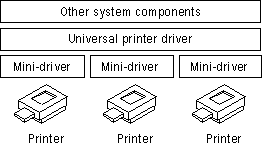Printer Driver Support
The Windows 95 device driver model includes two parts: a universal driver and a mini-driver. This device driver model makes it easier for printer manufacturers to create drivers for their printers. Windows 95 provides the universal printer driver, which communicates with other parts of the operating system and includes information pertinent to all printers. Printer manufacturers provide mini-drivers to communicate with the universal driver and with the printer itself. The following sections describe the universal driver and the PostScript mini-driver provided in Windows 95.
Note
Mini-drivers written for Windows 95 also work with the Windows NT 3.5 universal printer driver.

Universal Printer Driver
The Windows 95 universal printer driver supports mainstream page description languages, including HP PCL®, Epson® ESC P/2, Canon® CaPSL, Lexmark PPDS, monochrome HP GL/2, and most of the older dot matrix technologies. Almost all non-PostScript printer drivers provided with Windows 95 are based on universal driver technology.
The universal printer driver has full support for device-resident Intellifont and TrueType scalable device fonts. It also supports downloading of TrueType outlines to PCL printers with TrueType rasterizers. Enhancements offer support for downloading unbound TrueType outlines and of character sets with more than 256 characters.
The universal printer driver includes the following:
- Full 600 dots per inch (dpi) support; changes allow future expandability to higher resolutions
- Monochrome HP GL/2 support, providing full LaserJet® 4 functionality
- Generic Text support using TTY.DRV
- Support for ESC P/2 raster graphics directly through the universal driver, rather than through mini-drivers
- Easy-to-use properties dialog boxes for configuring printer driver settings
PostScript Mini-Driver
Microsoft worked closely with Adobe Systems to develop a PostScript mini-driver, which offers the following features:
- PostScript Level 2 support. This feature is automatically enabled for printers reporting as Level 2 from their PostScript Printer Description (.PPD) file.
- Additional support for Image Color Matching (ICM). The PostScript driver allows the server to offload ICM to the PostScript processor to improve performance. This flexibility allows you to take advantage of color raster enhancements on either the printer or the server.
- Control over output data format. The PostScript mini-driver supports ctrl+d handling, Binary Communications Protocol (BCP) and Tagged Binary Communications Protocol (TBCP), and pure binary (8-bit) channels (AppleTalk®).
- Support for version 4.2 .PPD files. These are ASCII files in driver-readable format which contain printer model information that drivers and other software retrieve in order to control a printer. These files cannot be edited. For compatibility, Windows Printer Description (.WPD) files are still supported.
- Support for Simplified Printer Description (.SPD) files. When a printer is installed, Windows 95 reads the .PPD files for each PostScript printer and creates an .SPD file, which is a simplified version of the .PPD file containing only information used by the Windows 95 PostScript mini-driver.
Important Windows 95 does not support editing of .PPD, .SPD, or .INF files. If you need to change these files, contact Adobe Systems.
- Tracking of PostScript virtual memory availability in the printer. This allows you to print more complex documents than you could with Windows 3.1. However, if the printer sends a message saying it can't print because it doesn't have enough virtual memory, you can resolve the problem by changing the PostScript options settings from Optimize For Speed to Optimize For Portability.
- Easy-to-use properties dialog boxes for configuring printer driver settings.
- Support for installable device options, as described in the .PPD file, through the user interface.

